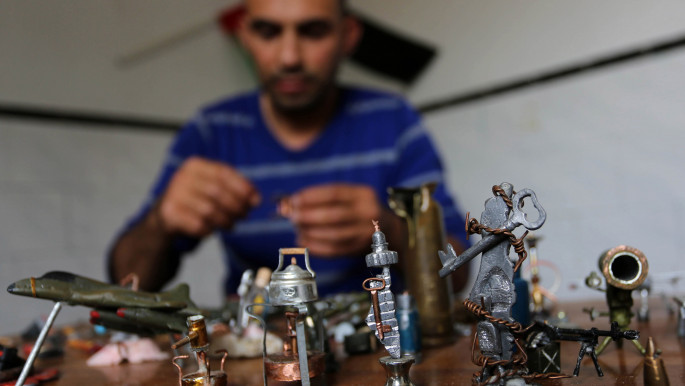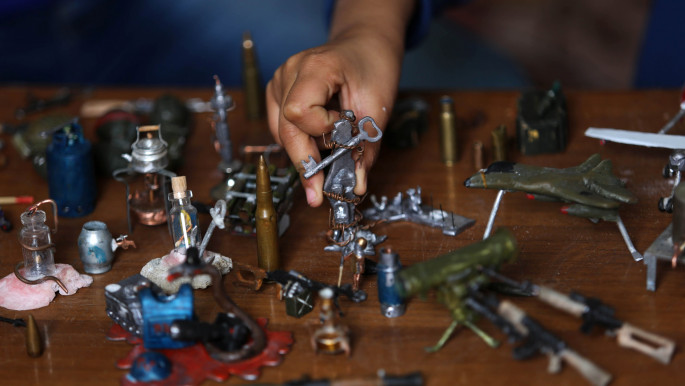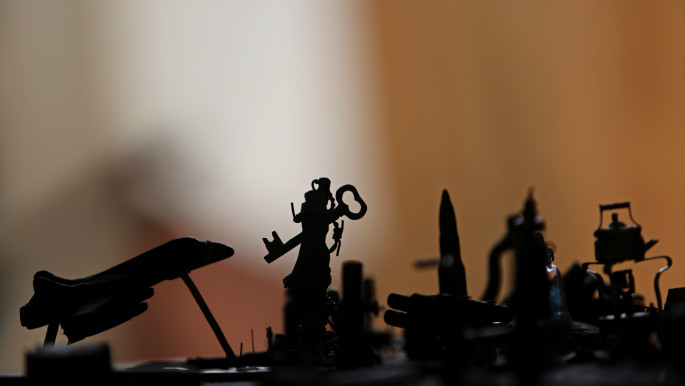Ammunition into art in Gaza
But this is exactly what Majdi Abu Taqiyya is doing - turning bullet cases and gas canisters, shot by Israeli forces towards Palestinians, into works of art.
Majdi's work is inspired by what is happening in his hometown, from protests against occupation, to unlawful killings by the Israeli army to the ongoing sieges, preventing thousands from living an ordinary life.
The crafts are available at a room in his home in central Gaza Strip's refugee camp of Nusierat.
"The idea came to my mind on the second Friday of the Great Return March protests when my brother Ahmad was shot and wounded near the border with Israel in central Gaza Strip," Majdi explains.
"Ahmad asked me to sculpt remnants of the bullet that penetrated his leg, knowing that I can do that."
The 38-year-old retired PA police personnel and father of three tells The New Arab that he made an ancient Kanaan soldier out of the live bullet that hit his brother's leg.
Read also: Gaza's Great Return March is only the beginning of a fresh wave demanding Palestinian rights
For Majdi, the hobby began at the age of 12.
"When I was a child, I used to collect stones, sculpt and then paint them, turning them into various objects. After my retirement, I have been following the Gaza border protests, including the deaths and injuries. I felt prompted to resume my hobby," he says, as he makes ceramic material out of glue, corn powder and hand cream.
 |
|
| Majdi works from a room in his home in central Gaza Strip's refugee camp of Nusierat [Getty] |
At a small corner of his home, Majdi lines up his various micro sculptures.
Among them is one reflecting the camps on the border lines, where the Great Return March was organised. On five different locations, designated by the Hamas-led higher committee for the Great Return March, tens of thousands of Gaza's two million residents, including men, women and children, as well as entire families, marched on different Fridays towards farm lands, adjacent to the Israeli border fence.
Israeli troops shot and killed at least 125 Palestinians and injured thousands more since March 30. The massacre drew international condemnation, with the UN set to send war crimes investigators to the besieged enclave.
 |
|
| Majdi turns bullet cases and gas canisters into works of art [Getty] |
"For the artwork of the demonstrators' camp, I used material from flashlight bombs fired by the Israeli army at night for the small tents. The ambulance vehicle, along with the Israeli army vehicles are made of remnants of Israeli bullets. The tank was made out of remnants of about 20 bullets which I melted," Majdi tells The New Arab.
Two weeks ago, the Israeli army's bullets fired by snipers hit a 21-year-old paramedic, Razan al-Najjar, in southern Gaza. Razan's death, which caused outrage worldwide, prompted Majdi to make a miniature icon of her. The small sculpture depicts Razan in her paramedic outfit and can be found in Majdi's home workshop.
Read also: Razan al-Najjar was a threat to Israel, and they knew it
Majdi was also inspired by the killing of two Palestinian journalists at the hands of the Israeli army. At his workshop, there are two objects reflecting the cameras and vests of journalists Yaser Murtaja and Ahmad Hasanein, who were shot dead on the border lines during the march.
"To make these two objects I used remnants of tear gas canisters and my homemade ceramic material," Majdi says.
 |
|
| Majdi's work is inspired by what is happening in his hometown, from protests, to killings to sieges [Getty] |
The Rafah crossing terminal considered to be a vital lifeline to the outside world for over two million Palestinians of Gaza is among Majdi's arts and crafts.
Another aspect of influence on his work includes the ongoing gas shortage across the coastal Gaza Strip. Majdi's wife Walaa says that he made her two small gas canisters in a humorous response to the lack of gas available for cooking. "If we can't get the gas for our food, I might as well sculpt it for myself."
The 38-year-old hopes to exhibit his work at a public display one day in the future.
"I use basic materials to make my sculptures, and although they may be simple and small, they reflect on Palestinian lives here in the Gaza Strip," he tells The New Arab.
"I do hope that some local bodies, whether governmental or non-governmental, will help me with my own first exhibition of my work, so the world can see what Palestinians endure on a day to day basis," Majdi adds, as he wraps up after five hours in his workshop.
Rami Almeghari is a Palestinian freelance journalist living and working in Gaza.
Follow him on Twitter: @writeralmeghari
The New Arab Meets: Click on our Special Contents tab to read more on our ever-growing archive of interviews





 Follow the Middle East's top stories in English at The New Arab on Google News
Follow the Middle East's top stories in English at The New Arab on Google News


